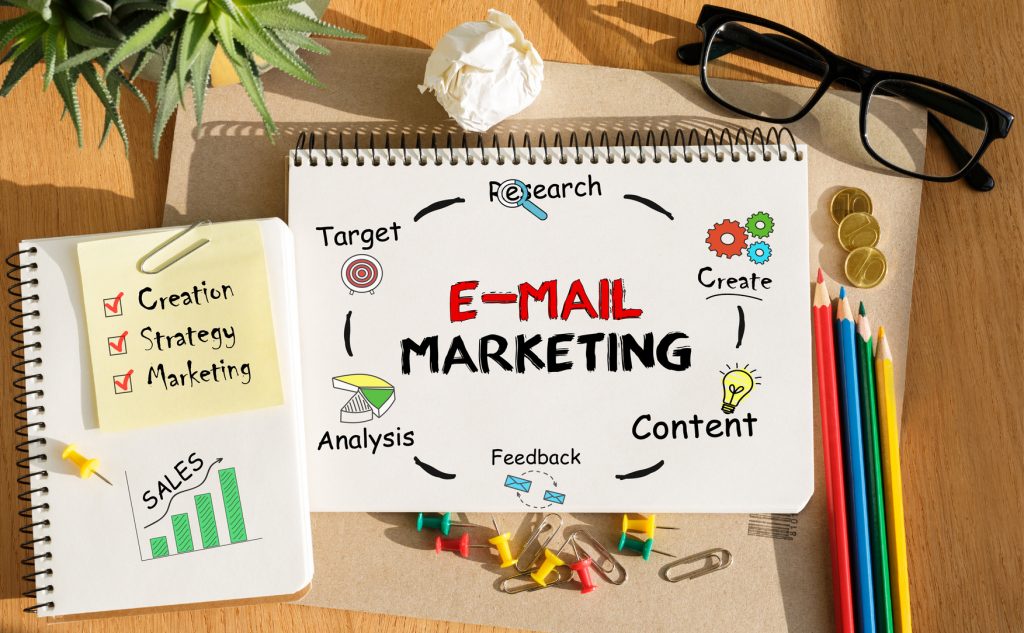
Search engine optimization (SEO) and content marketing naturally complement each other. High-quality content that’s optimized with more keywords to generate strong SEO drives your site’s ranking higher in SERP (search engine results pages). You can employ the same strategies in writing content for email marketing as you do the content for your company’s website.
Email marketing generates a return on investment (ROI) that’s four times higher than then next highest ROI—which is generated by social media marketing. It costs next to nothing to start an email campaign, and once you’ve established a good system, you’ll rarely need to invest more than a few hundred dollars at a time.
The overview
Once you’ve started to build your database of subscribers, you can use those email blasts to highlight your company’s best work, new promotions, useful information, or other content you know your audience will value. If your company’s been featured in the news, contributed to innovative tech development, or hired one of the industry’s brightest and best professionals, use this medium to broadcast the news. It will drive people to your website, and as people see the value of what you offer, they’ll engage and share it further.
Inbound links are critical for establishing your site’s and company’s authority. You need that strong link profile to maximize SEO. Those blast emails—cheap and instantaneous—push and boost attention to the content posts on your website. As long as the content on your website includes new information to cite, you’ll get an influx of new links. You can even invite readers to share their own experiences—via testimonials—depending on the products or services you offer.
Sending emails regularly—whether daily, weekly, bi-weekly, or monthly, for example—encourage more customer loyalty and improve your brand’s reputation. Whenever you’ve got a new special, your company earns kudos or awards, has a new service or product to offer, or insight into the industry of which you’re a part, spread the news in an email. Customers who are loyal to your company are more likely to advocate on behalf of your brand, too.
Don’t forget to embed links to social media accounts within the emails you send. Add a graf that encourages readers to follow your company/brand on social media channels—whether it’s Facebook, Instagram, or Twitter. Customers who follow you on social media can boost engagement and encourage other potential customers to follow and engage, too. Social media activity and followers don’t directly boost SEO results but these components can indirectly boost SEO by increasing the visibility and reach of your site—thus increasing its potential to earn more inbound links.
Remember to incorporate a variety of options and calls to action (CTA) on your website and social media profiles that invite visitors to sign up for email. When you consistently engage with followers and regularly create and publish great content, you’ll grow your subscriber base. You can also grow your email list with these 50 tips.
Strategies that drive traffic and improve SEO campaigns

Encourage email engagement by generating messages with a focused content that also includes some kind of CTA: asking users to leave comments on your website’s blog; requesting that users share posts; inviting readers to interact with your company on social media.
Encourage website subscribers, which will increase user engagement over time. Again, ask readers to subscribe to your social media channels where they’ll get the most current updates. Offer free subscriptions to your product, newsletter, or blog—it’s great for adding more website traffic and boosts SEO, too. Whenever you can offer something useful for free, people respond.
Develop and create an email newsletter series to generate leads and increase website traffic and your subscriber base. Start by determining the length of your newsletter series—a 7 to 14-day run with plenty of useful content is a good start—and then provide subscribers with a place to sign up. Don’t forget to include email verification to ensure you’re getting real people and not bots. On the final day of the series, include CTA that might be links to trials, demos, or subscriptions and are designed to turn subscribers into customers.
Google doesn’t index emails, so you can’t get that SEO directly from email campaigns but if you publish information you’ve shared in emails on your company’s blog, Google will take note. So, if you’ve got a newsletter series started, expand on the content within the emails on the blog, and add a link to the blog in each email. Or, write a summary of your blog’s newest post and send in an email blast, again with a CTA that invites readers to learn more about it by visiting the blog itself.
Depending on your industry, you may find it useful to create digests, which are great for driving more traffic to a blog. If you have the time to comb the web for articles and curate them into a digest, and then create an email that includes a sneak peak of this information you know your audience will find helpful, you’ll drive more traffic to your website and potentially reengage inactive subscribers.
Create a newsletter archive on your site so that search engines will rank your email text. An added bonus is that site visitors can see what you’re sending to subscribers, and if they find that information useful, they’ll subscribe, too. Remember to optimize headlines, add keywords and attributes so that the search engines can see the content.
In a nutshell…
Use the same best practices to write email content as you do for the blog and other content on your website. Always include some sort of clickable CTA. And follow these optimization tips:
- Research and invest in a good email service provider (ESP) who can provide analytics, a dedicated IP address, and assistance managing internet service providers (ISP)
- Maintain compliance with the CAN-SPAM law.
- Create a text-only version of your email so you can reach all audiences.
- Tailor your email campaigns to target specific demographics, interests, and preferences by using the list segmentation—those custom fields you can create in your customer relationship management (CRM) system.
- Add social media links and a CTA for readers to engage.
- Cultivate a strong initial subscribership—it doesn’t have to be huge, though, to start. Begin by growing it organically.
- Ensure each email offers something of value to subscribers, whether it’s tips/suggestions/ideas, new information, discounts, or anything specific to your industry.
- Don’t spam your subscribers. Often, less is more, so consider starting out with fewer emails (like weekly) so your subscribers don’t unsubscribe or do stop paying attention and opening up the emails.
Integrate SEO best practices when you design your HTML email templates, add canonical tags, and write effective subject lines (think of them like meta titles/ descriptions). For more ideas on how to blend SEO into your emails, check out this article.
While they might initially appear mutually exclusive, email marketing and SEO really can work together to increase and improve your results, earn more sales, and retain more customers.
Contact 9Sail today if you’re interested in increasing the traffic and conversion of your website!
Helpful resources
Discover the power of effective digital marketing.
Sign up to receive 9Sail’s exclusive content and tactical tips, focused on helping law firms grow.
9Sail takes your privacy seriously and will only use your personal information to deliver communications you have requested of us. You can change your preferences at any time.

